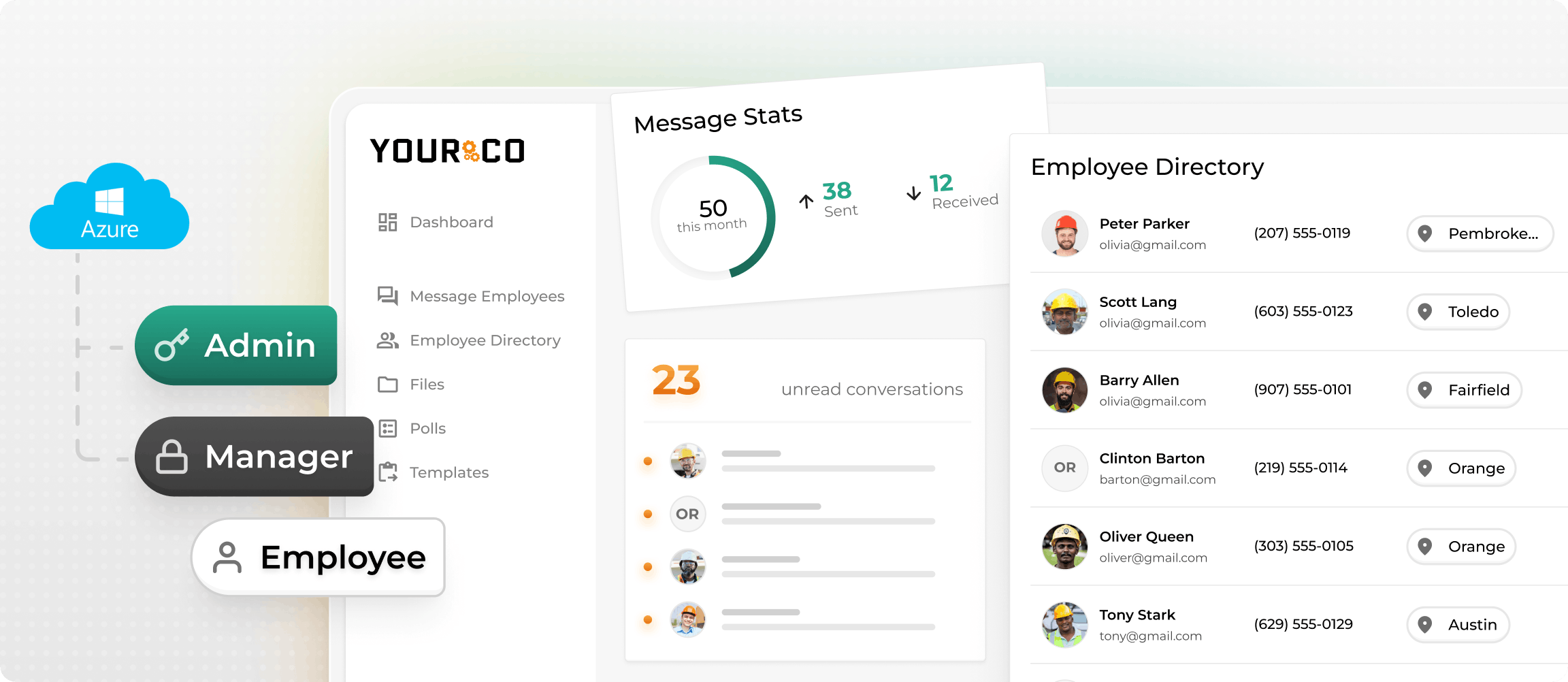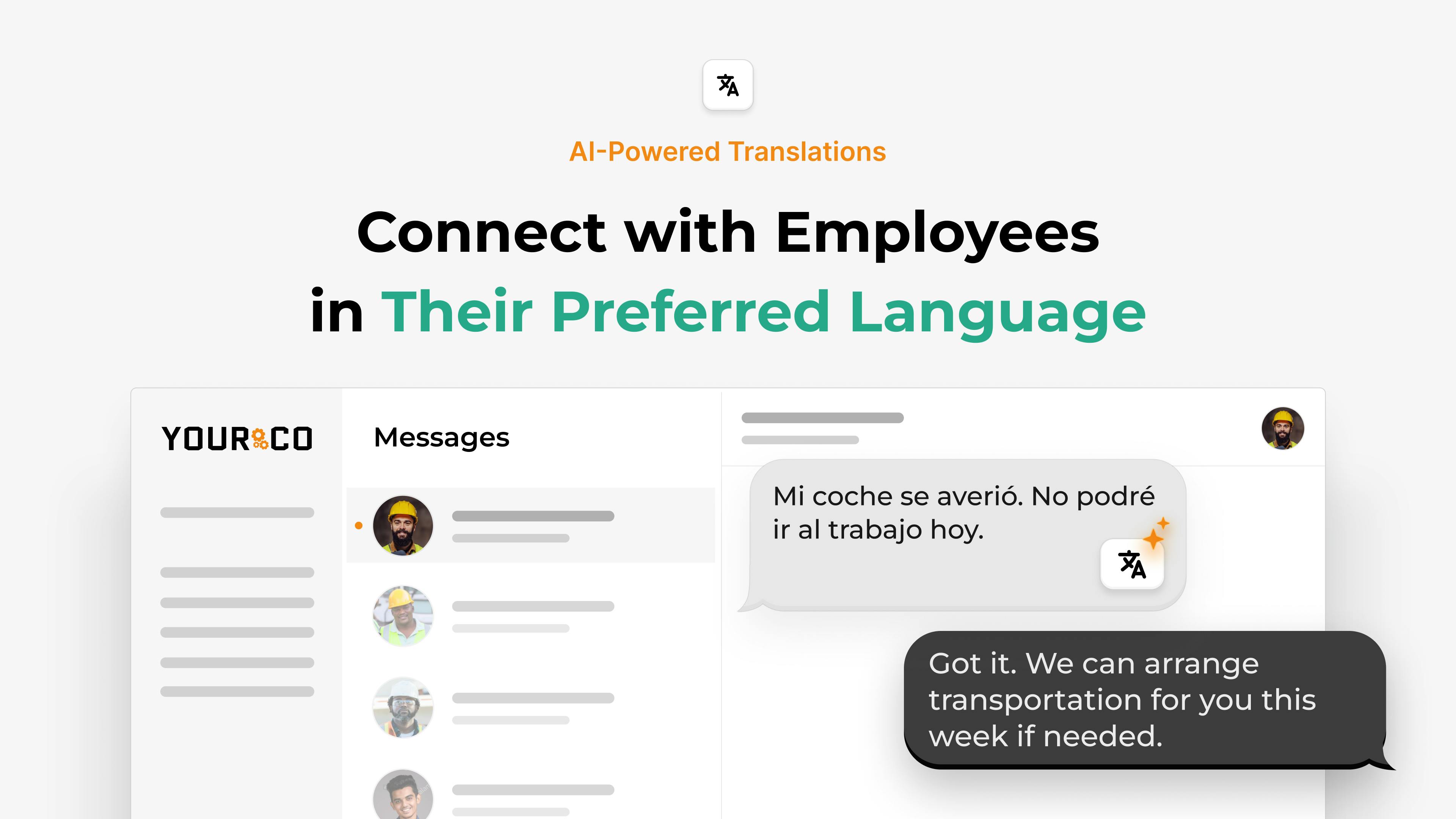Multilingual Workforce Management: Strategies for Supporting Non-English Speakers


Picture a warehouse where an alarm blares and instructions go out in English, but half the team cannot respond fast enough. That small gap can cause real damage. When employees do not fully understand directions, safety suffers, deadlines slip, and trust fades.
Managing a multilingual workforce starts with clear systems that let every worker receive, understand, and respond in their own language. This guide shows how to build those systems, from mapping language needs to automating translations and using quick text surveys to keep communication open.
Recognize How Language Barriers Hurt Your Operations
When messages don't land in the language your people think in, safety, productivity, and trust all take a hit.
Picture a busy loading dock where a supervisor shouts, "Hold the line!" Two new hires hear only noise. One steps into the forklift path, the other keeps stacking boxes in the wrong zone. These moments happen more often than you'd think, because missed words become missed warnings.
The consequences extend beyond safety incidents. Workers who can't understand instructions clearly need constant clarification. Tasks get repeated. Simple processes become slow. This confusion turns manageable deadlines into expensive rush orders, creating a cycle of inefficiency that affects entire operations.
Communication barriers also damage workplace relationships. Non-native speakers feel left out when pay updates, policy changes, or shift opportunities arrive only in English. This exclusion builds resentment over time, ultimately leading to higher turnover rates. HR leaders across multilingual workplaces see this pattern repeatedly.
Effective communication goes beyond translation. It preserves the urgency behind "Hold the line!" so every worker understands not just the words, but why they matter. When safety instructions carry the same weight in Spanish as they do in English, your entire team stays protected.
Create Communication Systems That Work for Everyone
Language gaps often hide in plain sight until an error or injury occurs. A practical system starts with knowing who speaks what, standardizing key messages, and opening true two-way dialogue.
Identify Preferred Languages and Literacy Levels
Start during onboarding by asking every employee to choose a preferred language for text and voice, recording it alongside their wages and emergency contact information. Follow up with one simple question: "Is it easier for you to read, listen, or watch instructions?" This respectful approach reveals whether someone learns best through visuals, audio, or plain text.
Combine the responses into a language map that shows which departments rely on Spanish audio, Vietnamese visuals, or English text. Update this map every few months as teams change, helping you focus translation efforts where they matter most.
Standardize Translated Templates for Key Scenarios
Translating messages on the fly creates confusion and missed details. Pre-written templates keep everyone on the same page for critical communications:
Write each template in short, direct sentences. Skip idioms and jargon. "Stack boxes six high, no higher" translates cleaner than "Keep pallets from getting too tall." Store master versions and translations together so updates happen instantly.
Before rollout, test understanding with a quick verbal quiz or picture walkthrough. If more than one in ten workers hesitates, simplify the wording and test again.
Provide Two-Way Communication Channels
One-way messages feel like orders. Two-way channels build trust. Make it just as easy for a team member to ask "¿Necesito casco aquí?" as it is for you to send a helmet reminder.
SMS systems like Yourco that auto-translate replies let workers type in their own language and still reach you instantly. Route incoming messages to the appropriate team, whether that's supervisors, safety leads, or HR, so questions reach the right people instantly and bilingual team members can assist when needed.
Log every exchange in your safety records. Over time, question patterns show you where instructions remain unclear, helping guide your next round of template improvements.
Equip Your Supervisors to Bridge Language Gaps
Supervisors shape how well every message lands on the shop floor. When language gaps remain, misunderstandings snowball into injuries and frustration. Clear, respectful coaching turns supervisors into everyday interpreters and culture-builders.
Use Plain Language and Visual Reinforcement
Strip sentences to the basics: one idea, one verb, no slang. "Turn the valve left until the gauge hits 60" works better than "Give it a tweak counter-clockwise until you're in the green." Pair each step with symbols, color cues, or photos so workers can double-check meaning at a glance. Visuals plus plain words give employees two chances to get it right.
When posting instructions, aim for a 6th-grade reading level and break long paragraphs into single-line commands. This approach helps everyone, not just non-English speakers. Focus on replacing confusing phrases with clear alternatives: "Place the padlock on the switch" instead of "Lock it out," or "Safety gloves and goggles" instead of "PPE."
Reinforce Safety and HR Policies in Every Employee's Language
Translate critical procedures first: emergency exits, machine start-up, wage updates. Post the same notice side-by-side in every major language so no one feels singled out. This demonstrates that everyone receives identical information.
After each training session, run a quick three-question quiz in the worker's language to confirm understanding. Keep it simple: printed, texted, or verbal all work. Store scores and sign-offs in a shared log that protects you if regulators request proof that everyone received the same information.
Model Inclusive Behavior
Workers take their cue from you. Slow your speech, face the person, and ask open questions like "What step comes next?" to check comprehension without embarrassing anyone. Invite clarifications with phrases such as "Tell me if any word isn't clear."
Lean on bilingual teammates to bridge short exchanges, but rotate the role so one person doesn't get stuck translating all day. When employees see you pause for questions and give equal airtime to every accent, trust grows. Better communication follows, and so does safety.
Streamline Messages Across Languages
When your updates arrive in each worker's language, confusion drops and shifts run on time. Digital tools make that possible without adding extra steps for you or your crew.
Automate Translations for Daily Updates
Smart translation tools now convert messages in real time, keeping context and tone intact across hundreds of languages. Look for platforms that cover every language spoken on your floor, handle industry-specific terms, and remember each employee's preference so you never send duplicate alerts. Start small with routine shift texts, gather feedback, then expand to safety notices and wage reminders.
Segment Messages by Location and Department
Blanket broadcasts overload phones and bury critical details. Instead, create groups by language, site, and job role so that welders in Plant A receive only the updates they need, in a language they understand. Targeted segments speed decision-making and cut chatter. Once your HR system stores language data, SMS platforms like Yourco can sync that information automatically, keeping lists up to date as teams change.
Centralize Message Logging for Compliance
Storing every outgoing text and employee response in one place protects you during audits and accident investigations. A single log proves that safety instructions reached Spanish- and Vietnamese-speaking staff the same minute they reached English speakers.
Choose tools that time-stamp messages, track delivery, and export records on demand. Consistent logs cut legal risk and reveal patterns, like which shifts need clearer instructions, giving you a roadmap for the next round of improvements.
Gather Feedback from Every Team Member
When every worker can speak up in their own language, you spot problems sooner and build real trust.
Use SMS Surveys and Polls
SMS remains the most reliable way to reach everyone on the floor. Texts get read far more often than email, with internal alerts achieving significantly higher open rates. Keep each survey short and focused:
- Start with a greeting in the worker's preferred language
- Ask clear questions
- Follow with an optional open prompt for additional comments
Timing matters as much as translation. Send polls right after a shift ends or on payday so replies don't disrupt production. A cadence of one pulse survey every two weeks gives you fresh data without feeling intrusive.
When responses come in, segment results by language group. If Spanish-speaking teams report lower safety confidence than English speakers, you know exactly where to focus training efforts. Close the loop by texting a brief update so workers see their input leads to action. A simple "Gracias. Mejoraremos el protocolo de bloqueo" shows you listened and builds trust for the next survey.
Celebrate Cultural Diversity
Feedback identifies risks and also reveals what keeps people engaged. Ask employees which holidays, foods, or music matter most to them, then weave those responses into break-room calendars, cafeteria menus, or shift-change playlists. Simple gestures like posting Eid greetings on digital boards or organizing a Diwali snack table can reduce the social isolation that often affects minorities.
Recognition doesn't require big budgets. A monthly culture spotlight text invites storytelling across languages and sparks conversations during breaks. Try asking "Reply with a photo of your favorite hometown dish" to get people sharing. These shared moments boost morale and directly combat the turnover linked to feeling like an outsider.
This approach transforms communication from a one-way broadcast into a living dialogue where every worker feels heard and valued.
Simplify Multilingual Workforce Management With Yourco
Managing a multilingual workforce doesn't have to be difficult. Yourco helps every employee stay informed and included through simple text messaging that works on any phone, with no apps or internet required.
With AI-powered translations in more than 135 languages and dialects, Yourco automatically delivers each message in the employee's preferred language. Safety updates, policy reminders, and schedule changes reach everyone in seconds, even those using basic flip phones.
You can also use built-in SMS surveys and polls to collect feedback or confirm understanding after a training or announcement. Responses appear in real time, allowing HR and operations teams to follow up and keep communication open.
Every message and response is time-stamped and stored automatically, creating a reliable record for audits and compliance. Messages can be segmented by department, shift, or location, so the right people always get the right information at the right time. Managers can send updates and review responses directly from their computers, keeping communication organized and secure.
Try Yourco for free today or schedule a demo and see the difference the right workplace communication solution can make in your company.
Frequently Asked Questions
How can I communicate HR updates with employees who don't use email?
Text messages reach any phone, even basic models, and get read almost immediately. Urgent news like shift changes or policy updates reaches workers instantly through SMS. SMS communication tools like Yourco help you schedule and translate messages in seconds, making sure everyone stays informed.
What's the best way to ensure translation accuracy in workplace messages?
Keep sentences short, avoid slang, and build a library of approved workplace terms. AI handles initial translations well, but double-check safety notices and legal updates with a bilingual team member. This simple review process prevents the miscommunications that often cause problems on the floor.
How can I gather feedback from non-English speakers quickly?
SMS polls work perfectly. Workers reply in their preferred language during breaks or on their way home. Response dashboards show you trends immediately, helping you address concerns before they become bigger issues.
How does Yourco help maintain compliance with multilingual documentation?
Yourco automatically logs every text sent and received, including language, timestamp, and content, in secure archives. You can export records for audits or incident reviews within minutes, proving that every worker received critical updates in their chosen language. No more searching through personal phones or paper trails when compliance questions arise.




